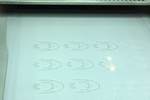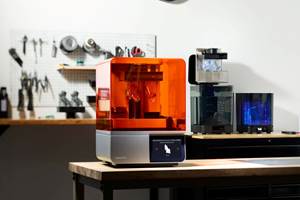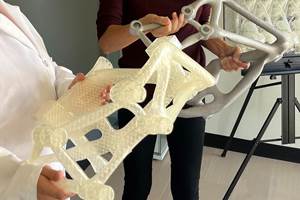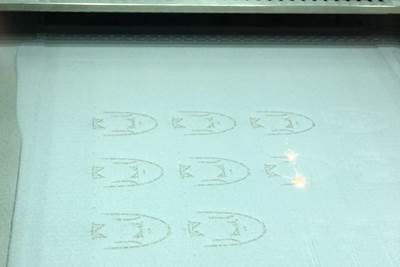To illustrate the power of an open-source laser powder bed fusion (LPBF) system, Venkata Karthik Nadimpalli, senior researcher with the Additive Manufacturing Lab of the Technical University of Denmark (DTU), passes a magnet over a sleeve of metal filings which in turn is held over a solid, 3D printed block of steel. The filings align to form the words, “Open AM.” The reason: Inside that solid block are two different phases (or atomic arrangements) of the same steel, one magnetic and one not magnetic, with the dividing line between the phases controlled to make the shapes of these letters. It’s more than a neat trick; the potential applications include solid metal parts with sensing and feedback capabilities built in. But to control material properties in this way, to this accuracy, in-process heat treating had to be programmed into the LPBF build file. Certain laser passes in certain regions were run with the laser acting to just heat the metal rather than melt it. This programming was possible because of the combination of software and hardware allowing for line-by-line manipulation of the program and component-by-component control of the LPBF machine.
That level of openness is what DTU has aimed to advance with the development and recent launch of its Open AM LPBF system, part of its Open Additive Manufacturing Initiative. The launch debuted this past year not at an industry expo or similar event, but on GitHub, the open-source code-sharing site. Instructions for building an LPBF machine from standard components and the code for software for programming it are now downloadable from GitHub. The downloads are free, but developing them was far from it. David Bue Pedersen, the DTU professor who leads the Additive Manufacturing Lab and its Open AM Initiative, says the work is “the culmination of 38 man-years’ worth of R&D,” funded thanks to a grant from the Poul Due Jensen Grundfos Foundation, established by pump maker Grundfos.

David Bue Pedersen of the AM Lab at DTU says the open-source LPBF machine, a version of which is running behind him, is the culmination of 38 man-years of research. The aim was to design and characterize a laser powder bed fusion machine platform, and its accompanying software, built entirely from third-party components, then make the code and specifications freely available via download.
Why do this? That is, why create an entirely open-source laser powder bed fusion system from the ground up, when commercial LPBF systems are thriving in production applications today? As it happens, the first two users of the Open AM system (its beta users) illustrate what are perhaps the two major areas of benefit. One user is an industrial trade school in Denmark. Operational cost is the benefit this user sees. The school can provide hands-on LPBF experience to students, while maintaining the system using standard, third-party hardware. The other user is a research institution, and here the major value is the chance to modify any component of the machine or any aspect of its build programming for the sake of experimentation on processing strategies and the material properties they produce.
But those examples do not fully answer the question: Why develop, and why make available, an open-source LPBF machine? I went to DTU’s Additive Manufacturing Lab in Copenhagen, Denmark, to see the machine in action and talk to the team in more detail about these questions.

The Additive Manufacturing Lab at DTU has 25 Ph.D.-level staff members and works on AM application and technology projects with more than 100 companies.
Polymer Predecessor: Open-Source Vat Polymerization for Micro 3D Printing
The DTU AM Lab team has done something like this before. Prior to starting work on the LPBF system, the group introduced an open-source vat polymerization system for polymer AM (also available on GitHub). Here, the chief advantage of the open-source system is not necessarily cost of use, because the cost of commercially available vat polymerization machines has steadily declined. The prime advantage instead is process control. On their lab-developed vat polymerization platform, built from standard third-party components, DTU researchers routinely 3D print at resolutions below 4 microns in voxel size, producing micro-scale components just hundreds of microns in size with feature dimensions as small as 10 micron. This is precision not attainable on typical commercial vat polymerization machines, notes Dr. Nadimpalli, and it the direct product of the researchers’ ability to explore curing times resulting from light intensity for various materials at various build conditions, then use the open-source platform to dynamically vary light exposure in time with other machine parameters to leverage this process knowledge.

The AM Lab's more established open-source success is in vat polymerization. Venkata Karthik Nadimpalli (left) says the freedom for experimentation and process control on this machine has allowed for printing resolution finer that commercially available photopolymer AM systems generally realize. He is seen here speaking with Stephanie Hendrixson of Additive Manufacturing Media, who will soon be posting a series of videos providing more detail about features of the Open AM vat polymerization system. Subscribe to our newsletter The BuildUp to learn when they appear.
Similarly, commercially available laser powder bed fusion machines have not offered this extent of process control. Laser wavelength, spot size and beam shape; plus hatch spacing, scanning speed and laser power; along with layer thickness, scan angle and scan path length; combined with the variables inherent to the powder material; combined with interactions among all these variables and others; plus the contribution of novel in-process modifications such as the heat treating mentioned above, are all potentially meaningful for determining part geometry and metal property outcomes in laser powder bed fusion. But commercial LPBF machines do not allow for direct and minute control over these many different elements. To varying degrees, the software controlling these machines instead offers a more streamlined user interface that drives combinations of settings for these parameters. This limits what level of independent process research, and therefore process advance, is possible.
Dr. Pedersen says, “As a result, much of additive manufacturing research is at the level of advanced bird watching.” In LPBF in particular, software essential for programming the machine provides the only available access to hardware conditions of the machine. As a result, he says, “Researchers can only say they set machine parameters to X according to X software.” What they generally cannot do is tune every process input to an assured, measured setting through direct hardware adjustment.
And there is a reason for this — a reason why existing commercial machines and software are engineered this way, without more direct process control. This is because LPBF potentially can do so much. It potentially addresses different needs of so many different applications. Precisely which outcomes should be sought and controlled for varies considerably for different users. The most reasonable course, therefore, has been for LPBF technology providers to tailor process engineering to the needs of different applications one at a time, in order of the potential reach and demand of that development.
Which comes back to Grundfos. The pump manufacturer headquartered in Bjerringbro, Denmark, maker of more than 16 million pumps per year, had come to recognize the value of AM for the production components of future pump designs. But its engineering teams struggled to pursue this value on commercially available systems. Some geometry and material property aims Grundfos hopes to realize (Dr. Pedersen hinted at examples, but asked that the details not be publicized) can seemingly be attained through laser powder bed fusion, but Grundfos faced limitations in how far it could manipulate existing LPBF machines and processes to advance these aims.
The Grundfos Foundation, majority owner of the company, is a philanthropic organization funding technical research (along with causes involving water and inclusion). To accelerate AM adoption and the realization of its many promises for manufacturing and engineering, the Foundation awarded DTU a grant of 2.4 million euro to create fully modular and freely available AM systems for both polymer and metal. The vat polymerization work was already underway when the grant was awarded; it is the open-source LPBF machine that most fully owes its existence to this grant. Manufacturers in general will benefit from the availability of this system — that general benefit is the philanthropic aim of the Foundation’s giving — but one of those manufacturers is apt to be Grundfos itself.

Build volume on the Open AM LPBF machine, if built according to the downloadable specification, is 250 mm in diameter by 150 mm high.
Open-Source Laser Powder Bed Fusion Machine Specs
The research has involved designing and characterizing a laser powder bed fusion machine platform, and its accompanying software, able to function effectively when built entirely from third-party components. The resulting DTU Open AM LPBF machine, when built according to the instructions on GitHub, offers a cylindrical build volume 250 mm in diameter by 150 mm high. Laser spot size is 60 micron, powder handling includes internal sieving, layer height can go as small as 20 micron, and the developers say the chamber’s strong cross-flow ensures part quality via beam consistency while minimizing chamber cleaning. The controller code is fully open and — here is a feature not typical of commercial LPBF systems — the machine has native dual-powder feed offering the chance for multimaterial builds that vary metal by layer.
To assemble the machine entirely from scratch using the GitHub documentation and code is possible for a technically astute organization or user. Whether doing so is economical is another question. According to Dr. Pedersen, “You could build the machine for about 100,000 euro, if you do not count your salary.” No one outside DTU has yet done this.
Instead, the value is in the information about every aspect of the machine’s assembly and operation. This access provides the freedom to replace and update key components as they wear or as better options become available, and it also shows the way to alter any component and any section of the software code as needed to operate in a different way that realizes some specific outcome or hope of LPBF.
“It is a machine that is completely demystified,” Dr. Pedersen says. “So you are not afraid to take a screwdriver to it.”
Indeed, modification by users is the hope. Dr. Nadimpalli says, “What we want now is for more users to take this platform and develop it further.”
The two Open AM LPBF machines in use now, both beta machines, were built by the DTU Additive Manufacturing Lab. Eight more machines have been promised to other users. These will be built by the Lab’s team as well, at the pace this team is able to deliver them.
“We are researchers, not machine builders,” Dr. Pedersen says. And he says DTU and the AM Lab leaders all recognize the limitation in this. For the spread of the open-source systems for metal AM and polymer AM both, finding a way to become a machine builder, or (more likely) to partner with a machine builder, might be the logical next step in this work.
Related Content
Medical Molder Relies on 3D Printing to Speed Development of Inspection Fixtures
Medical molder Medbio uses FFF and SLA 3D printers in designing (and sometimes producing) its inspection fixtures.
Read MoreFormlabs’ Form 4 3D Printer Offers New Levels of Reliability and Speed for Stereolithography
The Form 4 is designed to deliver most parts in less than two hours, offering users a powerful, affordable tool to bring ideas to life at fast speeds with excellent reliability, print quality and ease of use.
Read MoreWhy Customization at Mass-Market Scale Is Finally Possible With 3D Printing
Printer speed and materials coupled with scanning technologies are contributing to more affordable and accessible 3D printed, personalized goods.
Read MoreIntrepid Automation: How Investment Casting Benefits From High Speed DLP
Vat polymerization 3D printing for investment casting patterns offers a way to deliver design freedom at production speed.
Read MoreRead Next
What is Powder Bed Fusion 3D Printing?
Whether in metal or polymer, with a laser or an electron beam, powder bed fusion (PBF) is one of the most widely used 3D printing techniques.
Read MoreBike Manufacturer Uses Additive Manufacturing to Create Lighter, More Complex, Customized Parts
Titanium bike frame manufacturer Hanglun Technology mixes precision casting with 3D printing to create bikes that offer increased speed and reduced turbulence during long-distance rides, offering a smoother, faster and more efficient cycling experience.
Read More3D Printed Polymer EOAT Increases Safety of Cobots
Contract manufacturer Anubis 3D applies polymer 3D printing processes to manufacture cobot tooling that is lightweight, smooth and safer for human interaction.
Read More





















